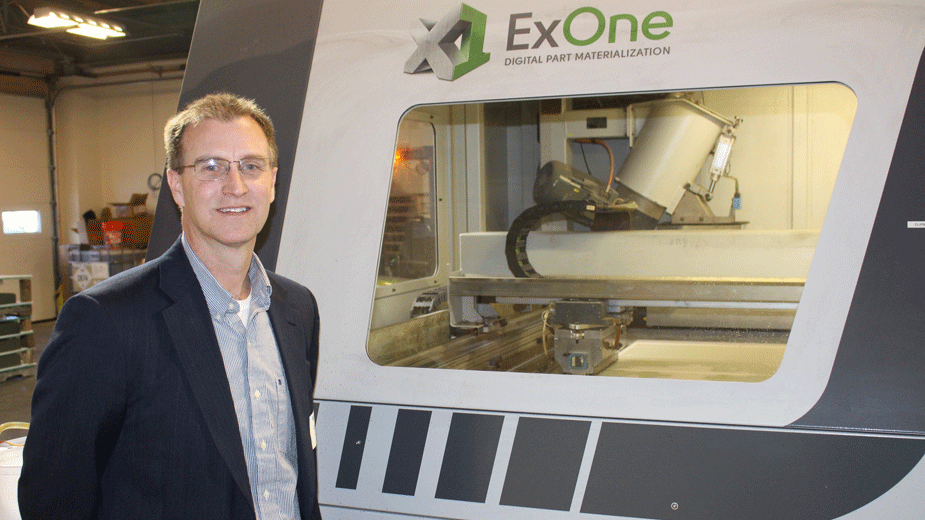More Companies Making 3-D Printers, More Using Them
LEETONIA, Ohio – The market for additive manufacturing technology continues to rise, marked by an increase in the number of companies embracing the process and developing the capabilities behind it.
“You’re seeing a lot of new companies – everything from 3-D printer manufacturers to service bureaus and software developers,” said Rick Lucas, chief technology officer at ExOne, one of the nation’s largest manufacturers of additive manufacturing equipment.
Lucas was the keynote speaker at the Northeast Ohio Additive Manufacturing Cluster’s quarterly meeting, held at Humtown Products’ 3-D printing division at the Leetonia World Trade Park. About 70 attended the meeting on Wednesday.
Additive manufacturing has improved dramatically since the 1990s, when the technology was used to make prototypes from polymer material, Lucas said. Over the last 10 years, 3-D printers are more sophisticated and are able to manufacture components from metals, ceramics, plastics, sand, and other materials.
His company, ExOne, manufactures large-scale 3-D printers with binder-jetting capability, Lucas said. These printers deposit a binding agent on material in a powdered form. This material then solidifies in the shape of a component or part as the binder jet moves along a pre-programmed pattern, much like a paper printer.
The company augments its manufacturing division with a print-on-demand contract service and a casting service for customers, Lucas said. It’s print on demand service, for example, takes a customer’s request via a digital file and feeds it into one of ExOne’s printers. The part could be printed and then delivered to the customer in a matter of days.
3-D printers are able to make intricate parts or components that would be difficult to manufacture through traditional methods, he said.
Advances in technology over the last five years have helped improve the speed, efficiency and the quality of parts manufactured through additive production, Lucas said. Indeed, the number of companies manufacturing 3-D printers has grown in just the last two years, he said.
In 2015, for example, Lucas told group members that there were 70 companies manufacturing 3-D printers in the United States. In 2017, there were 114 such companies.
“In the last five years, you’ve seen machines improve in resolution, robustness, the quality of parts they produce, and the speed in which they make these parts,” Lucas said.
Further improving these features only stands to broaden the market for additive manufacturing, he added.
ExOne has found success selling and providing 3-D printing services to clients in the automotive, oil and gas, heavy equipment, and aerospace industries, Lucas said.
“Consumers are demanding more from products,” Lucas said. “Additive can fill that need. We see a lot of interest as well as investment in additive because of that reason.”
More companies find that using 3-D printed parts for their production capabilities has helped make their businesses more efficient.
Carrie Matheney, CEO and president of Shirley K’s Storage Totes & Trays in Zanesville, said that her company uses tooling manufactured on a 3-D printer to manufacture finished parts for her customers.
“The benefits are low-cost tooling, short lead times, and we’re able to create a solution for folks who don’t have a large budget,” she says. The company has used 3-D printed tools to manufacture plastic parts inside a piece of furniture, some parts for the automotive industry, and components used on medical equipment.
“Another one was an application for a molding tray that’s being used to make bricks,” Matheney said.
Humtown Products saw the potential of integrating additive manufacturing into its production processes more than five years ago. The company partnered with the Youngstown Business Incubator, Youngstown State University and America Makes to develop a 3-D printing operation that produces sand cores for the foundry and castings industries.
Last year, the company opened its 3-D printing division in Leetonia to complement its core production facility in Columbiana, said Brandon Lamoncha, Humtown’s sales manager.
“We saw 3-D printing as the next logical step for us,” he said.
Initially, the company worked with what was then the sole 3-D sand printer in the United States at the University of Northern Iowa. That led to opportunities to consult with original equipment manufacturers. “This is the first sand printer in Ohio,” he noted.
Lamoncha said that acquiring the proper equipment was an important step. What remains is conducting the proper training in order to prepare the workforce on how to understand and operate these machines. “We need to equip the workforce,” he said.
Additive manufacturing has opened up opportunities in the antique automobile restoration market, which provided the initial basis for establishing Freshmade 3D, a Youngstown additive manufacturing company that is advancing the technology through the use of new materials, said its chief technology officer, Brett Conner.
The company has engaged additive manufacturing where few have thought it possible. Freshmade has used 3-D printing to make two life-size bobble heads of then presidential candidates Hillary Clinton and Donald Trump during the 2016 election; was commissioned to manufacture large animals such as frogs, butterflies and birds for a mural at Akron Children’s Hospital; and even used additive manufacturing to produce a 14-pound bowling ball.
“What we are trying to show is that we have something here that is durable,” Conner said of the bowling ball. “We’re thinking differently here. This is something you’d never expect” from a 3-D printer.
Pictured at top: Rick Lucas is the chief technology officer at ExOne, one of the nation’s largest manufacturers of additive manufacturing equipment.
Copyright 2024 The Business Journal, Youngstown, Ohio.


